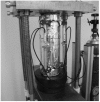Time-Dependent Material Properties of Shotcrete: Experimental and Numerical Study
- PMID: 28892007
- PMCID: PMC5615721
- DOI: 10.3390/ma10091067
Time-Dependent Material Properties of Shotcrete: Experimental and Numerical Study
Abstract
A new experimental program, focusing on the evolution of the Young's modulus, uniaxial compressive strength, shrinkage and creep of shotcrete is presented. The laboratory tests are, starting at very young ages of the material, conducted on two different types of specimens sampled at the site of the Brenner Basetunnel. The experimental results are evaluated and compared to other experiments from the literature. In addition, three advanced constitutive models for shotcrete, i.e., the model by Meschke, the model by Schädlich and Schweiger, and the model by Neuner et al., are validated on the basis of the test data, and the capabilities of the models to represent the observed shotcrete behavior are assessed. Hence, the gap between the the outdated experimental data on shotcrete available in the literature on the one hand and the nowadays available advanced shotcrete models, on the other hand, is closed.
Keywords: constitutive model; creep; damage model; material tests; plasticity model; shotcrete; shrinkage; sprayed concrete.
Conflict of interest statement
The authors declare no conflict of interest.
Figures













References
-
- Pöttler R. Time-dependent rock-shotcrete interaction—A numerical shortcut. Comput. Geotech. 1990;9:149–169. doi: 10.1016/0266-352X(90)90011-J. - DOI
-
- Schädlich B., Schweiger H.F. A new constitutive model for shotcrete; Proceedings of the 8th European Conference on Numerical Methods in Geotechnical Engineering; Delft, The Netherlands. 18–20 June 2014; Leiden, The Netherlands: CRC Press Taylor & Francis; 2014. pp. 103–108.
LinkOut - more resources
Full Text Sources
Other Literature Sources
Miscellaneous

